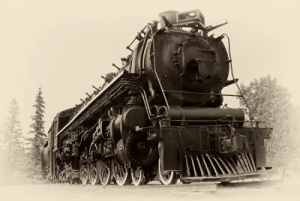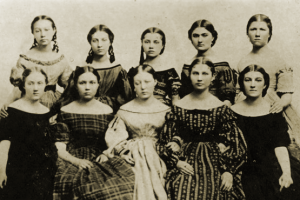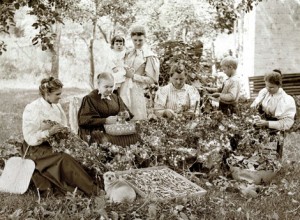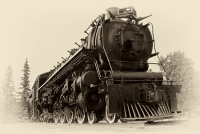The Relief Society played a starring role during the Saints’ 3rd decade in the Utah Territory in the Church’s efforts to protect their economic unity from the anticipated negative effects of the completion of the transcontinental railroad.
 In 1865, Brigham Young had suggested women organize around the goal of promoting in-home manufacturing and self-sufficiency, and several such groups were organized. Two years later, President Young publicly called for the re-establishment of the Relief Society in every ward. Church Historian Leonard J. Arrington concluded that that call was motivated by a desire to prevent the draining of the wealth of the Saints by the merchandisers of the East who they anticipated would tempt the sisters with inexpensive tea and coffee as well as the latest fashions. This draining of the Saints’ wealth would damage the community’s ability to foster their own economic growth and self-sufficiency.
In 1865, Brigham Young had suggested women organize around the goal of promoting in-home manufacturing and self-sufficiency, and several such groups were organized. Two years later, President Young publicly called for the re-establishment of the Relief Society in every ward. Church Historian Leonard J. Arrington concluded that that call was motivated by a desire to prevent the draining of the wealth of the Saints by the merchandisers of the East who they anticipated would tempt the sisters with inexpensive tea and coffee as well as the latest fashions. This draining of the Saints’ wealth would damage the community’s ability to foster their own economic growth and self-sufficiency.
Arrington then lists three major tasks the Brethren asked for the help of the Relief Society, all three of which were designed to lessen the economic impact of the railroad’s arrival.

The first was to launch the Young Ladies Retrenchment Societies which were specifically motivated by President Young’s desire to discourage the young women from wasting their means on the fashions of “Babylon” that would only impoverish themselves and enrich the merchants. The girls were taught to wear clothes of their own making as well as to “glean wheat, piece quilts, crochet, make hats, [and] knit stockings….”
The second task asked of the Relief Society was to assist in the launching and management of the cooperative general stores, including ZCMI. The sisters were asked to shop exclusively at the cooperatives, set up their own co-ops to sell homemade goods, and even to invest in the cooperatives themselves.

The third task was to support the home industry movement. It’s leaders called upon every branch of the Relief Society to “lay hold of this subject of home industry… and to take an active part in the great work of bringing about the perfect organization of a self-sustaining people.” As a result, among other accomplishments, every one of the local Relief Societies had a silk production project during the 1870s.
With the help of the Relief Society, the coming of the railroad did not result in the immediate swallowing up of the Mormon economy by the Eastern capitalists as had been anticipated. That economic subjugation was postponed for another two decades.
Your thoughts?
